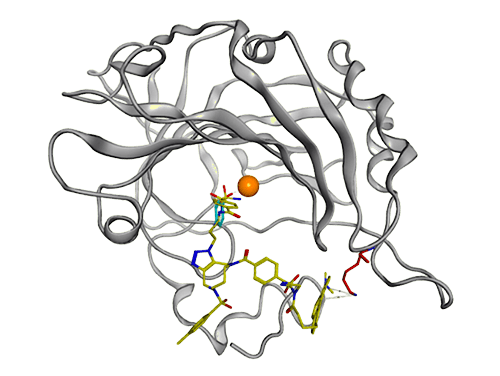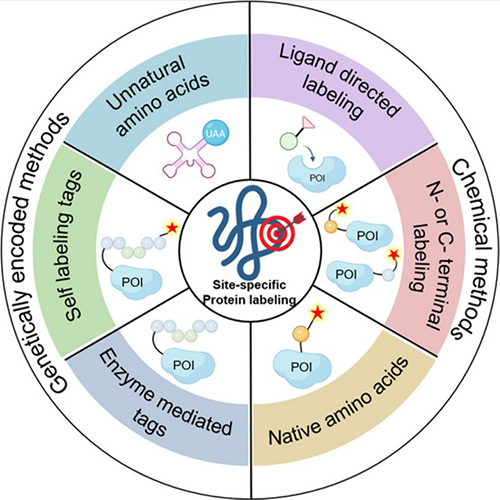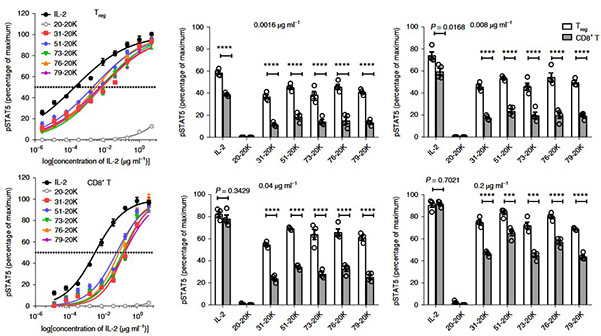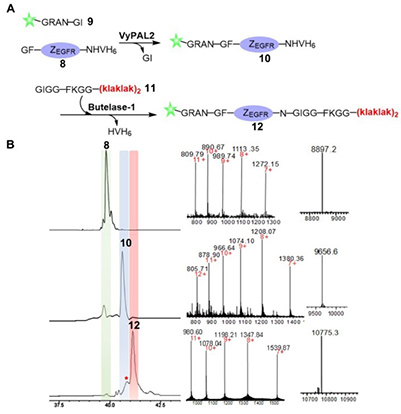Site-Specific and Custom Labeling
Creative BioMart offers advanced Site-Specific and Custom Labeling Services designed to support precise and reproducible protein labeling under biologically compatible conditions. With decades of expertise in protein expression, purification, and bioconjugation, our services address the technical challenges associated with protein labeling—ensuring optimal label incorporation, structural integrity, and downstream usability. Whether your application requires N-terminal, C-terminal, or glycosylation site labeling, our team delivers fully customized solutions using cutting-edge chemistries such as CuAAC, SPAAC, and TCO-Tz ligation. Our commitment to quality, flexibility, and innovation ensures reliable results for even the most demanding research projects.

Background: The Need for Custom and Site-Specific Protein Labeling

Figure 1. Site-specific protein labeling. (Ma et al., 2024)
In modern life sciences research, precise biomolecule labeling plays a crucial role in protein structure-function analysis, biophysical studies, imaging, and therapeutic development. However, conventional random-labeling methods often compromise protein function or result in heterogeneous populations, undermining experimental reproducibility.
To address this, site-specific labeling strategies have emerged as essential tools, enabling the controlled attachment of functional probes (fluorophores, affinity tags, drugs, etc.) at predetermined positions on the protein. These techniques ensure:
- Defined label-to-protein ratios
- Preserved biological activity
- Reduced background signal and nonspecific binding
- Improved data reproducibility and interpretation
Nonetheless, achieving these results requires specialized knowledge in protein engineering, chemical biology, and purification technologies—an area where Creative BioMart stands at the forefront.
What We Offer–Tailored Labeling Solutions Integrated with Protein Expression
Service Procedure
-
Duration: 1–3 business days
1
Project Consultation
- Define labeling strategy based on protein structure, function, and downstream application.
- Selection of optimal site (N-terminus, C-terminus, glycosylation site, etc.)
-
Duration: 1–3 weeks
2
Custom Protein Expression & Purification
- High-yield protein production using optimized expression systems.
- Rigorous purification protocols to ensure structural integrity.
-
Duration: 1 week
3
Labeling Chemistry Selection & Preparation
Choose the appropriate site-specific reaction method:
- Cu-Catalyzed Azide-Alkyne Cycloaddition (CuAAC)
- Strain-Promoted Azide-Alkyne Cycloaddition (SPAAC)
- Tetrazine–trans-Cyclooctene (TCO-Tz) Ligation
-
Duration: 1-2 weeks
4
Labeling Execution Under Physiological Conditions
- Neutral pH, aqueous environment, low reactant concentrations to preserve function.
-
Duration: 1-2 weeks
5
Post-Labeling Quality Control
- Removal of unbound probes.
- Label-to-protein ratio determination.
- Structural/functional verification via SDS-PAGE, mass spectrometry, or ELISA.
-
Duration: 1–2 business days
6
Final Deliverables
- High-purity, site-specifically labeled protein ready for your research.
Our Labeling Capabilities
- N-terminal Labeling
- C-terminal Labeling
- Glycosylation Site Labeling
- Bio-orthogonal Reaction Labeling
- Single/Multi-Site Labeling
- Labeling with Fluorophores, Biotin, PEG, Click Chemistry Handles, etc.
- Custom Linker Integration Upon Request
Why Choose Creative BioMart for Protein Labeling
- Custom-Tailored Solutions: Each project is uniquely designed based on your experimental needs, protein properties, and downstream applications.
- Advanced Site-Specific Technologies: We utilize industry-leading bio-orthogonal chemistries for precise and efficient conjugation.
- Integrated Expression-to-Labeling Workflow: Unlike off-the-shelf services, we integrate protein expression, purification, and labeling into a seamless pipeline to minimize variability and maximize yield.
- High Labeling Efficiency with Biological Integrity: Labeling is performed under physiological conditions to preserve protein activity and stability.
- Extensive Technical Expertise: Backed by decades of protein chemistry experience, we tackle complex challenges including poor solubility, inconsistent labeling ratios, and probe instability.
- Fast Turnaround and Competitive Pricing: We deliver high-quality, ready-to-use labeled proteins on a reliable timeline, while ensuring cost-effectiveness for labs of all sizes.
Applications of Site-Specific Labeling in Research and Industry
* NOTE: We prioritize confidentiality to safeguard our clients’ technology and intellectual property. As an alternative, we present selected published research articles as representative case studies. For details on the assay services and products used in these studies, please refer to the relevant sections of the cited literature.
Case 1: Site-specific PEGylation of interleukin-2 enhances immunosuppression
Zhang et al., 2021. doi:10.1038/s41551-021-00797-8
Site-specific PEGylation significantly enhances the therapeutic potential of interleukin-2 (IL-2) for autoimmune diseases by improving its pharmacokinetics and half-life. Using a copper-free click reaction, PEG moieties were orthogonally conjugated to IL-2 at defined sites via azide-bearing amino acids. The resulting PEGylated IL-2 exhibited sustained activation and expansion of regulatory T (Treg) cells over a wide dose range, selectively targeting the trimeric IL-2 receptor. In mouse models of lupus, arthritis, and graft-versus-host disease, the modified IL-2 improved efficacy without impairing antiviral immunity. This approach demonstrates that site-specific PEGylation can optimize cytokines for safer, more effective autoimmune disease therapies.

Figure 2. Dose-dependent assessment of IL-2 variants containing 20 kDa PEG at different sites in the activation of Treg cells over CD8+ T cells by the pSTAT5 assay for comparisons of their selectivity in hPBMCs. (Zhang et al., 2021)
Case 2: Engineering protein theranostics using bio-orthogonal asparaginyl peptide ligases
Wang et al., 2021. doi:10.7150/thno.53615
A novel bio-orthogonal protein labeling strategy using two distinct asparaginyl peptide ligases, butelase-1 and VyPAL2, enables precise dual modifications of therapeutic proteins. These enzymes exhibit unique substrate specificities, allowing sequential and site-specific attachment of different functional groups to recombinant proteins. By engineering proteins with the respective recognition motifs, researchers successfully labeled an EGFR-targeting affibody with a fluorescein dye (N-terminus) and a mitochondrion-lytic peptide (C-terminus), resulting in a potent imaging and cytotoxic agent for EGFR-positive cancer cells. This tandem ligation technique also facilitated the creation of a cyclic affibody–doxorubicin conjugate, significantly enhancing cytotoxicity. The method offers a powerful platform for generating multifunctional protein theranostics.

Figure 3. Bio-orthogonal protein dual labeling using VyPAL2 and butelase-1. (A) N-to-C tandem ligation scheme. Fluorescein-peptide 9 was first ligated to the N terminus of ZEGFR 8 via VML to give 10 which was then ligated with peptide 11 at C terminus via BML to give 12; (B) HPLC and LC-MS analysis of N-to-C ligation. The ligation products 8, 10, 12 were purified by reverse-phase HPLC and analyzed via ESI-MS. (Wang et al., 2021)
Client Experiences with Our Custom Protein Labeling Solutions
“We needed precise C-terminal labeling of a recombinant antibody fragment for conjugation to a fluorescent dye in our imaging assay development. Creative BioMart delivered exactly what we needed—high-purity, site-specifically labeled protein with excellent batch consistency. The label-to-protein ratio was right on target, and the fluorophore retained full functionality without compromising binding affinity.”
— Principal Investigator | Academic Cancer Research Institute
“Our team was developing a novel biosensor that required dual labeling of a protein at both N-terminal and glycosylation sites. Creative BioMart designed a tailored workflow combining strain-promoted azide-alkyne cycloaddition and selective glycan modification. The result was a fully functional, dual-labeled construct that exceeded our sensitivity benchmarks. Their team’s technical depth made a big difference.”
— Senior Scientist | Biotechnology Startup
“For a vaccine formulation study, we needed tetrazine-trans-cyclooctene ligation to site-specifically attach our antigen to a nanoparticle surface. Creative BioMart provided not only the labeled antigen but also valuable advice on optimizing the linker chemistry. The labeled antigen performed well in immunogenicity assays, and the service saved us weeks of troubleshooting.”
— R&D Director | Biopharmaceutical Company
“We partnered with Creative BioMart for site-specific PEGylation of an enzyme for improved in vivo half-life. Their expertise in Cu-catalyzed click chemistry and protein purification allowed us to scale from pilot to preclinical batches efficiently. The final product showed enhanced stability and maintained its catalytic activity. Their team was responsive, detail-oriented, and flexible throughout the process.”
— Project Manager | Drug Delivery Platform Company
FAQs on Site-Specific and Custom Protein Labeling Services
-
Q: What types of site-specific labeling do you offer?
A: We offer a full range of site-specific labeling options, including N-terminal labeling, C-terminal labeling, and labeling at glycosylation sites. We also support click-chemistry-based techniques such as Cu-catalyzed azide-alkyne reaction, strain-promoted azide-alkyne cycloaddition (SPAAC), and tetrazine-trans-cyclooctene ligation for precision and biocompatibility. -
Q: Can you accommodate custom labeling strategies based on our project needs?
A: Absolutely. Our service is highly customizable. Whether you need a single-site label, dual-labeling, or specialized chemistries, we’ll collaborate with you to design the most effective and biologically compatible approach tailored to your specific application. -
Q: What is the typical turnaround time for a custom protein labeling project?
A: The full process usually takes 4–8 weeks, depending on the complexity of the protein, labeling chemistry, and any expression or purification needs. We also offer accelerated timelines for urgent projects—just ask! -
Q: How do you ensure that the labeling process doesn’t affect the protein’s function?
A: We use biocompatible labeling chemistries that operate under mild, physiological conditions to preserve protein structure and activity. All proteins undergo thorough quality control, including activity assays, SDS-PAGE, and label-to-protein ratio analysis. -
Q: What kind of deliverables and documentation can we expect?
A: You will receive high-purity labeled protein, detailed QC reports (purity, label confirmation, functional assays if applicable), and full documentation of expression and labeling protocols—everything you need for downstream applications or regulatory filings. -
Q: Can you handle labeling for difficult or aggregation-prone proteins?
A: Yes. We specialize in integrating protein expression, purification, and labeling into a seamless process, which helps prevent common issues like aggregation, precipitation, or inconsistent labeling. Our proprietary workflows are designed for both robustness and flexibility.
Resources
Related Services
References:
- Ma Y, Wang Y, Wang F, Lu S, Chen X. Site-specific protein labeling: Recent progress. Chinese Chemical Letters. 2025;36(8):110546. doi:10.1016/j.cclet.2024.110546
- Wang Z, Zhang D, Hemu X, et al. Engineering protein theranostics using bio-orthogonal asparaginyl peptide ligases. Theranostics. 2021;11(12):5863-5875. doi:10.7150/thno.53615
- Zhang B, Sun J, Wang Y, et al. Site-specific PEGylation of interleukin-2 enhances immunosuppression via the sustained activation of regulatory T cells. Nat Biomed Eng. 2021;5(11):1288-1305. doi:10.1038/s41551-021-00797-8
Contact us or send an email at for project quotations and more detailed information.
Quick Links
-

Papers’ PMID to Obtain Coupon
Submit Now -

Refer Friends & New Lab Start-up Promotions

